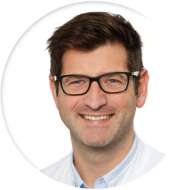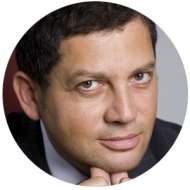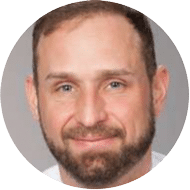7 clinicians,
experts in their field and having long experience with cerabone®,
give detailed answers to the most important questions about its clinical use.
Choice of particle size and integration time
How do you decide for the use of large or small cerabone® granules?
Does the time of integration of the cerabone® particles depend on the size of the granules?
Prof. Dr. Dr. Rothamel: I mainly use small particles for nearly everything, except large sinuses and socket preservation, where I sometimes use big particles. Small granules provide better local stability and are easier to handle. In large sinuses and socket preservation, the stability is provided by the defect itself and we need space for ingrowing bone.
Dr. Steigmann: For GBR and socket preservation, I only use the small particles. The time until we can place implants depends on whether we use cerabone® alone or in combination with autogenous bone or maxgraft®.
PD Dr. Dr. Kämmerer: I prefer to use the small particles for all indications. Nonetheless, in my opinion, the regeneration of both particle sizes should be the same.
Dr. Maghaireh: I generally use large particles for sinus grafting and ridge augmentations. I use small particles for ridge augmentation. I personally believe that integration and remodeling takes place quicker and better when we use large particles, but as they can be sharp and hard to contain underneath a membrane, I prefer to not use them for ridge augmentation. However, I am not aware of any clinical trials comparing time of integration between both.
Dr. Papi: Well, in my opinion large granules are more suitable for sinus lift procedures, while I use small granules in socket preservation, contour augmentation, GBR around dental implants and periodontal regeneration around teeth.
In my expertise, there is no difference in the integration of cerabone® based on the size of the granules – you just need to wait more for sinus lift (6-9 months). I usually perform re-entry surgery after socket preservation at 4-5 months, finding a good quality and quantity of bone.
Dr. Frosecchi: Small particles can be used in all treatments, but generally are more indicated for GBR treatments. Large particles are generally more indicated in sinus augmentation and large self-space making defects, where we want to leave more space for blood clot and less protection from mechanical factors.
Dr. Eslava: In our clinical practice we only use small particles, especially because of the risk of long-term flap perforation with larger particles that are not going to be resorbed. Occasionally we have used them (large particles) in extensive sinus elevations but always in combination with autologous grafts.
The graft integration time does not depend on the particle size, it depends on the porosity of the graft, the crystallinity of the hydroxyapatite and the residual calcium concentration.
Mixing of cerabone® before application
Do you have any special recipes for mixing cerabone® before application?
It is said that cerabone® cannot be used in its pure form. Is it true?
Prof. Dr. Dr. Rothamel: I like to mix cerabone® with some autologous bone whenever I am able to get some. cerabone® also works alone especially in smaller augmentations, but then it needs a bit more time for integration.
Dr. Steigmann: For GBR we mix cerabone® with autogenous bone harvested with a scraper. When lacking autogenous bone, we mix with maxgraft®.
PD Dr. Dr. Kämmerer: cerabone® can also be used alone, but of course, it has no osseoinductive properties. Thus, I use cerabone® alone mainly in contained defects, e.g. for ridge preservation or sinus floor augmentation. In challenging situations I mix it with allogeneic or, if available, with autologous bone chips in the ratio of 80:20.
Dr. Maghaireh: I am aware of the benefits of mixing cerabone® (or any other xenograft) with autogenous particles. However, I have been following the layering technique in the past where I get autogenous or allograft particles on the implant surface and then pure cerabone® on top of that as a second layer to achieve stable and maximum convexity. I have had great results with very little complications or disappointment. I am considering to start mixing cerabone® with autogenous or even with allograft as a second layer and see if there is any difference.
Dr. Papi: I hydrate cerabone® with sterile saline solution and then I generally use it alone, without autogenous bone. Sometimes I collect some bone chips from the burs while performing implant placement or using a bone scraper and I mix it in a 50:50 way with cerabone®, however I am a strong supporter of the use of cerabone® alone. In my opinion, there is no need to add autogenous bone.
Dr. Frosecchi: Personally, I use saline solution, blood or tetracycline solution. I use this last antibiotic association in case of infective risk cavities.
Dr. Eslava: We always suggest mixing cerabone® with PRF and with autologous bone obtained from the same surgical site, either by milling or scraping the adjacent bone. cerabone® can be used pure without mixing with any other material in surgical sites where adequate blood irrigation from the surgical site can be guaranteed as occurs in the maxillary sinus or in post-exodontic alveoli with intact bone walls.
Comparison of cerabone® (ml,cc) and Bio-Oss® (grams)
How can I compare cerabone® and Bio-Oss®?
Should I consider mass (grams) or volume (ml, cc) of the bone graft for the treatment of a bone defect?
Prof. Dr. Dr. Rothamel: Usually the plan is to fill up a volume and not make the patient heavier. Therefore, milliliter is the only unit that makes sense.
Dr. Maghaireh: cerabone® is heated to higher temperature when compared to Bio-Oss®, which does mean low resorption and thus a high degree of volume stability on the long term. This suites me very well as it works well with my layering technique. I never rely on pure cerabone® to cover the exposed implant threads and therefore, I do not need complete remodeling. However, it would be interesting to know the real difference in remodeling percentage between the two products five and ten years after grafting.
I would use volume (cc) to determine the amount needed to treat a certain defect.
Dr. Papi: The best way to compare cerabone® and Bio-Oss® is to compare the hydrophilic properties. And I think that this was exactly the reason behind my choice for cerabone®. Due to its different productive cycle and pore size, cerabone® has better hydrophilic properties.
When treating a bone defect, you are filling a cavity so obviously you should consider volume.
Dr. Eslava: Although both are xenografts of bovine origin, from the manufacturing point of view they differ greatly. cerabone® is processed at 1250 Celsius degrees, this is important in the crystalline phase of the hydroxyapatite crystals obtained at the end of the process and the amount of residual calcium carbonates. On the other hand there is the porosity of the particles, where the cerabone® particle is much more porous than that of Bio-Oss®. This is easily evidenced in the hydrophilicity tests with blood in both products, with cerabone being much more hydrophilic than the Bio-Oss®. From the clinical point of view the manipulation of both materials when mixed with PRF and with autologous bone is very similar. But when the surgical re-entry is done eight or ten months after the procedure, the differences are significant. There is more presence of particles in cerabone® than in Bio-Oss®, the integration of graft particles is very similar, but the big difference is in the vitality of the bone around the surgical site. Bleeding from the surgical bed in Bio-Oss® is significantly less than cerabone®.
All bone defects should be measured in cubic centimeters or cubic millimeters because we are treating surgical sites with a defined space. The weight given in grams only speaks of the density of the material but not of the space occupied by it.
Use of cerabone® in combination with a membrane
Do you use cerabone® without a membrane, for example in sinus floor augmentation?
Prof. Dr. Dr. Rothamel: I always use cerabone® in combination with membranes when there is a direct contact to soft tissue, even periosteum.
Dr. Steigmann: For GBR a membrane is always necessary when a bone substitute material is used, independent on whether the periosteum is intact or not. For closing a flap for GBR the elasticity of the flap in most of the cases is achieved with a periosteal releasing incision or split thickness flap.
PD Dr. Dr. Kämmerer: The use of a membrane does not depend on cerabone®, but on the clinical indication. In general and based on the literature, I would use Jason® membrane in lateral and vertical augmentations. In sinus floor augmentation, I use a membrane only in case of perforation of the Schneiderian membrane.
Dr. Maghaireh: The only time I would consider cerabone® without a membrane is internal sinus lift. Otherwise, I always use a membrane even with external sinus augmentation.
Dr. Papi: I usually associate the use of cerabone® with Jason® membrane when performing socket or ridge preservation, however sometimes I do not use a membrane when treating small defects around dental implants or for regenerative treatment of peri-implantitis.
Dr. Frosecchi: Yes, in sinus lift. Sometimes I associate cerabone® with mucoderm® in buccal volume augmentation.
Dr. Eslava: In some selected cases we use it that way, especially in surgical sites where the space is completely delimited by bone walls, for example in maxillary sinuses, post-exodontic alveoli with all bone walls intact. It can also be used in vestibular areas of implants where we want to achieve a stable volume without the need for true guided bone regeneration and we only want to improve the buccal contour of the surgical site.
“Sausage technique”
Can I use cerabone® in conjunction with the “sausage technique”?
Prof. Dr. Dr. Rothamel: The “Sausage technique” by Istvan Urban is just a stabilization technique for GBR using membranes in combination with pins. The procedure can also be performed with cerabone® e.g. in combination with Jason® membrane.
Dr. Steigmann: The “Sausage technique” is only a way to stretch the membrane after fixing with pins. The bone grafting material does not matter!
PD Dr. Dr. Kämmerer: Of course, cerabone® can be used for the “Sausage technique”. From a regenerative point of view, there are only marginal differences between cerabone® and Bio-Oss®.
Dr. Maghaireh: This is what I do routinely: “Sausage technique” using cerabone®.
Dr. Papi: You can obviously use cerabone® in conjunction with the sausage technique.
Dr. Frosecchi: Sausage technique is a recent technique, sufficiently documented with combination of Bio-Oss® and autologous bone. It should work with cerabone® too, but I think we need some specific study to demonstrate a similar outcome.
Dr. Eslava: Of course, cerabone® should be mixed with autologous bone and absorbable membranes of pericardium can be used to perform Dr. Urban’s Sausage technique, it is an excellent alternative because of the superb stability of the bone graft.
This technique can be carried out with any type of biomaterial, but the degree of reabsorption of the biomaterial to be chosen for this type of procedures must be taken into account, there are some materials that have a high turnover rate generating a volume of new bone quickly, but this same advantage is a disadvantage in this type of procedures, since the resurfacing of this material will be greater with the passage of time and much more once the implants are loaded and the structural strength of biomaterials
Differences in the clinical performance of cerabone® and Bio-Oss®
What differences in the clinical performance of Bio-Oss® and cerabone® have you observed?
Have you observed a difference in the visibility on the CT between Bio-Oss® and cerabone®?
Prof. Dr. Dr. Rothamel: cerabone® is sintered and Bio-Oss® is not. Therefore, the radio opacity is a bit higher for cerabone®. In addition, handling properties are a bit different since Bio-Oss® is more humid than cerabone®. On the other hand, hydrophilicity is higher for cerabone®. Both materials deliver the same result in all augmentation procedures.
Dr. Steigmann: The results are the same. cerabone® seems to show more radio opacity since it is sintered, however clinically the results are similar and cerabone® has a better volume stability.
PD Dr. Dr. Kämmerer: There is less data on the direct comparison of the two grafting materials available, but literature suggests no differences between cerabone® and Bio-Oss®. From a clinical point of view, I have experienced no differences between the two materials, except for the particle migration.
Dr. Maghaireh: cerabone® is hydrophilic which makes it much easier to use and manipulate. I see no real clinical differences between cerabone® and Bio-Oss® on the short term. Would be interesting to see what happens seven to ten years post-op in my hands. My gut feeling tells me that we will get better volume stability with cerabone®. I guess cerabone® will look more radio-opaque as it has higher stability and less remodeling and less resorption when compared to Bio-Oss®.
Dr. Papi: Well, the two materials are comparable. According to my opinion, the better advantages of cerabone® are its superior hydrophilic nature and different pore size. A difference I have noticed is that cerabone® is more stable than Bio-Oss®: when recalling patients, you can notice a smaller amount of vertical reduction at x-rays examinations.
In my opinion, cerabone® and Bio-Oss® look different on periapical x-rays and CBCT and I think this is due to the granules size and its subsequent different refraction of x-rays. You can notice a more porous aspect of cerabone, which is more similar to autogenous bone.
Dr. Frosecchi: My experience indicate that Bio-Oss® is generally integrated into bone and partially resorbed. cerabone® looks remaining longer without macroscopic resorption. This can influence outcome in both directions: can be useful in case of volume augmentation and can be not so useful in case of more predictable bone formation, as in case of sinus augmentation.
I’m not sure of a different x-ray aspect.
Dr. Eslava: During the manipulation of both grafts mixed with PRF and autologous bone that is our protocol we have not found differences. However, the hydration of both grafts is different, cerabone® being much more hydrophilic than Bio-Oss® due to the porosity of the particle. At the time of surgical re-entry between the 8th and 10th month, differences are observed as there are more cerabone® particles than Bio-Oss®, this is due to the crystallinity of the grafts and a notable difference is the degree of blood irrigation of both scarred grafts, being a site with much more irrigation in cerabone® than in Bio-Oss®. With a greater amount of particles remaining in cerabone®, the long-term stability of the graft is greater than that of Bio-Oss®, and you can see the bone vitality by yourself.
In tomographic images, if there are differences, since cerabone® is of greater crystallinity and when more particles remain in the surgical site, the image is observed with a higher density than the image seen in the Bio-Oss treated sites.
Complication management
What kind of mistakes should be avoided when working with cerabone®?
Is it a problem when separate granules are visible when opening during re-entry?
Prof. Dr. Dr. Rothamel: Of course we can observe complications with cerabone®, even if they are rare. But: Infection is NEVER a problem of the bone substitute material (they are sterile!), but a problem with handling. Both Bio-Oss® and cerabone® particles might be not completely integrated in newly formed bone at time of re-entry (more a result of the membrane), and in this case cerabone® is more visible since it is a bit whiter. The indications for Bio-Oss® and cerabone® are quite the same.
Dr. Steigmann: There are failures with every material; however, most of them are due to poor soft tissue management. In every case of using xenografts and opening, we find granules not integrated in the new bone.
PD Dr. Dr. Kämmerer: There are always failures possible, but I do not see any relevant difference to Bio-Oss®. Sometimes observed free particles in case of cerabone® I have found not to be relevant for the clinical outcome.
Dr. Maghaireh: No real failure with cerabone® so far as I am having great results with layering technique concept I have been following for the last few years. I strongly believe that failures and disappointments are usually attributed to techniques. Clinicians need to understand biology and the limitations of xenograft in general. For example, they should not use cerabone® pure in ridge augmentation and then go ahead and place the implant within four to six months, thinking they will get high degrees of remodeling. Also, it is highly recommended that we use the correct type of membrane according to the size of the defect. I personally prefer a well-stabilized Jason® membrane to provide good protection for the GBR and minimize risk of perforation and cerabone® particles migration.
Dr. Papi: I had a couple failures with cerabone®, especially on the first cases. When looking for possible causes I must admit that they were not related to the material (they were caused by patients not following post-operative instructions, such as brushing in the surgical area, not following the antibiotic therapy or not using chlorhexidine, therefore exposing and compromising the healing of the graft).
I have been using cerabone® since 2015, and I honestly have a very high success rate, also stressing the indication of the material, such as performing re-entry surgery at four months. In many of these cases, I found several separate granules on top of the grafted area but this is not a problem you just remove the most superficial ones and you can place your implant.
When using cerabone®, you should obtain a primary wound closure and carefully instruct patients to follow your recommendations; there are no “special instructions” for using cerabone®. It is very simple and straightforward, you just need to follow the basic principles of GBR.
Dr. Frosecchi: I observed some non-incorporation into bone. cerabone® was more attached to the soft tissue. This can be considered a failure of bone augmentation. I think that cerabone® should be recommended in cases of buccal volume augmentation, where stability is more important than bone incorporation and new bone formation.
A certain amount of granules separation at re-entry is acceptable. It’s a quantitative problem when too much biomaterial gets separated and not incorporated.
Dr. Eslava: Yes at the beginning of our learning curve with cerabone, year 2011, we made re-entries between the 6th and 8th month in places where we had made very extensive regenerations and found that the graft was not yet fully integrated into the surgical site.
On other occasions with very thin periodontal phenotypes the particles can perforate the gingival tissue even years after the surgical procedure. It is very important to note that cerabone® and apical lesions on adjacent teeth are not a good combination. Occasionally we have seen that in sites that have been regenerated with cerabone® many years ago and the adjacent tooth appears with an extensive apical lesion, it is very easy for the graft to contaminate rapidly.
The vast majority of failures with this type of biomaterials are associated with the manipulation of the clinician at the surgical time, the xenografts are not manipulated like the allografts, the healing times are different and the periodontal phenotype of the surgical site must be taken into account to evaluate if it is possible that in the future the remaining particles can pierce the flap.
There are a number of errors that should be avoided by the clinician at the time of using cerabone®: Evaluate with which solution the injero will hydrate (saline solution, blood or PRF). Consider always mixing the graft with autologous bone or with PRF to have A better clinic result. Use of membranes with sufficient resorption or degradation time. Ensure complete immobilization of the graft by means of fixing the membranes with prf or sutures or tacks or screws. Consider the minimum reentry time of six to eight months for post-exodontic alveoli, and eight to 12 months for extensive sinus elevations, and ten to 12 months for extensive horizontal and vertical bone regenerations. Evaluate the milling technique in the surgical site, milling sequence and never perform osseodensification. Avoid provisional contact especially if it is removable with the surgical site. In places where there are apical lesions, be sure to completely decontaminate the site to avoid re-infection of the graft.
It depends on the amount of granules separated, if there are a few, there is no problem, but if the graft is not integrated and easily detaches from the surgical site, the surgical procedure should be considered.

Prof. Dr. Dr. Daniel Rothamel
GERMANY
Head of Department, Oral and Maxillofacial Plastic Surgery, Johanniter Hospital Bethesda Mönchengladbach, Germany and Associate Professor, Heinrich-Heine University Düsseldorf, Germany.

Dr. Marius Steigmann, DDS, PhD
GERMANY
Founder and director of the “Steigmann Institute”.
Member of multiple associations (DGOI, FIZ, BDIZ and ICOI).

PD Dr. Dr. Peer Kämmerer
GERMANY
Medical Director of the Department of Oral-, Maxillofacial- and Facial Plastic Surgery at the University of Mainz, Germany.

Dr. Hassan Maghaireh
United Kingdom
Head of the Scientific Committee of The British Academy of Implant & Restorative Dentistry.
Study club director of the ITI in Leeds.

Dr. Piero Papi
ITALY
Research Fellow at the Oral Surgery Unit of the Department of Oral and Maxillo-Facial Sciences, at “Sapienza” University of Rome.

Dr. Massimo Frosecchi
ITALY
Fellow of Italian section of ITI and international ITI speaker.
Professor a c. in Implantology and Scientific evidences at University of Genoa, Italy.

Dr. Andrés Eslava Vanegas
COLOMBIA
National and International Speaker in osseointegration, guided bone regeneration and periodontal plastic surgery.
Several associations at Colombian universities.
